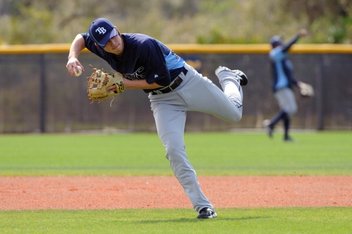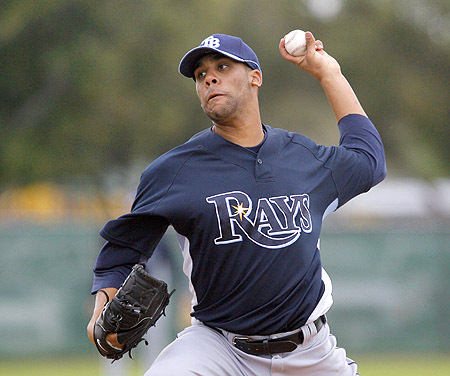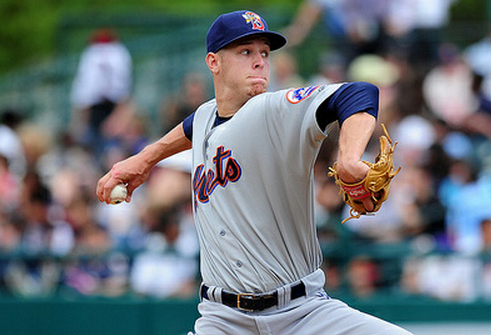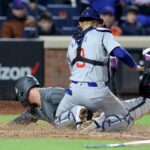It’s not enough for teams to match up with players simply based on positional need. There are teams who focus on certain types of players to fit an organizational structure, brand and philosophy said teams have built. This is why I think the Mets match up well with the Tampa Bay Rays. The Rays have a history of building through the draft, signing their star players early enough to buy out arbitration years as well as free agent years, thus keeping the cost to a minimum in light of the Rays’ dismal economic standing. They have no revenue stream from attendance and a bottom of the barrel payroll, and can’t afford any stars on the open market. That’s why they must control the cost of their own before it gets out of hand.
Case in point is the contract they’ve given to Evan Longoria, perhaps the most talented third baseman in baseball, who seemingly suffers season-altering injuries every year. Days after being called up to the majors in 2008, the Rays inked Longo to a six year, $17.5 million contract with three option years that would keep him Tampa through 2016 and pay him a grand total of $47.5 million, plus incentives, for nine years. That same year, the Rays signed James Shields to a four year, $11.25 million contract with three option years that could being his full deal to $39.25 million over seven years, also with added incentives. After making just one start in the majors in 2011, Matt Moore agreed to a five year, $14 million deal, plus those three options the Rays love that could pay Moore $40 million over eight years, plus the incentives he achieves. The Rays operate a certain way, specifically with pitchers.
He’d look good in blue and orangeBut there’s one pitcher they let slip away, one that might turn out to have a better career than all three players above. David Price does not have a long-term deal and is currently on a year-by-year team-controlled/arbitration salary. The Rays did try, signing him to a long-term major league contract in 2007, while he was still in the minors, but left the door open with a clause that stated Price could opt out of the contract and file for arbitration in any year in which he would have been arbitration-eligible. Price took advantage of that clause and opted out after 2011, electing for arbitration over the $1.5 million he would have made under the contract. The Rays and Price avoided arbitration by agreeing to a $4.35 deal, and now the Rays are in a bind.
Price is a leading contender for the American League Cy Young award. Even without the award, he’d likely earn $8 million in arbitration and the award could hike that up into double figures. With Price’s trade value at the highest it’s ever been, this might be a prime opportunity for the Rays to score a huge return instead of going year-by-year with Price through his next three arbitration years, potentially paying $35 million for those three years and receiving just draft picks in return. Sure, the Rays could trade him at any time over those three years, but seasons like the one Price just had aren’t easily replicated. The Rays should strike while the iron is hot.
Enter the New York Mets. Before the 2012 season, the Mets and pitcher Jonathon Niese agreed to a Raysian-type deal, guaranteeing Niese five years, and holding two options that could bring the total to a little under $47 million for seven years. Andrew Friedman likely stood and applauded. The solid season Niese had and the potential he showed is very nice, but not worth a potential Cy Young winner on its own. What else do the Mets have? The Mets also have a first baseman that is only entering his first arbitration year and cannot be a free agent for another four years, a very good candidate for a long-term deal that buys out a lot of those years. Eh, that’s better, but why can’t the Rays just re-up Carlos Peña for the umpteenth time and keep their ace? Fine. How about that DH Joel Sherman says the Rays have always liked? Ok, Mets, throw in your top pitching prospect, the Rays will return their top middle infield prospect (because they have two of them in their top-ten, according to Baseball America), a middle reliever, a 72-hour window to sign Price long-term (a la Johan Santana) and we have the principles of a deal.
The Mets get: David Price, Burke Badenhop and Hak-Ju Lee
The Rays get: Jon Niese, Ike Davis, Lucas Duda and Zack Wheeler
That’s a doozy. Let that simmer before reacting. Count to twenty and keep in mind that this is the principle of a proposed deal. Cash and/or minor prospects will also change addresses. Let’s look at the Pros and Cons from the Mets perspective.

Lee will likely stick as a long-term middle infield presence.
Pros: They are replacing Jon Niese with David Price and (probably) Manny Acosta with Burke Badenhop. This would be a huge boost to the pitching staff. I can show you stats for days, but it’s not necessary. The Mets would also be using Lucas Duda, who many have grown tired of and given up on, to return such a huge improvement. They would also be receiving a very highly regarded shortstop prospect with great speed, who, in 2012, had a really good stolen base percentage in 2012 (80%), a solid contact bat (.261/.336/.360) and, most importantly, plus defense up the middle. Lee had a full season at AA Montgomery and will be given a long look in Spring Training. He’ll likely begin the season in Durham and his arrival in the bigs projects to be as soon as he proves he can handle AAA and Elliot Johnson can’t handle the majors. With the Mets, he can take it a little more slowly. Daniel Murphy, who would now know his time was almost up, might be motivated to either keep his job, or make himself more attractive to another team, which would also benefit the Mets. Murphy isn’t eligible for free agency till 2016, and the Mets can do with him what they please for three more years. Increasing his trade value is obviously optimal, but worst case, Murphy is demoted to a super-sub, which is likely his best role on the team. There’s another option with Murphy, which I’ll address a little later. In case it’s not clear, I’m talking about moving Ruben Tejada to second base.Cons: I like Niese, but I get replacing him with David Price. But who’s going to play first base? Ike Davis had 32 home runs in a bad year. And Duda could hit 25 or so playing every day. That’s basically all of the Mets’ power, not to mention Davis is a stud defensively. How do you address that? And isn’t the best pitching prospect on the farm a little steep?
Well, you have to give up something to get something. To improve the pitching staff that drastically will cost you, and there’s the rub. The Mets will obviously have to downgrade at first base, but maybe not all that much. With the acquisition of Davis, the Rays will no longer need Peña. He still has power and still managed a better OBP than Davis, and is a better-than-average defender at first base. He earned $7.25 million in 2012, but could see that number fall to as low as $5 million, which is affordable. James Loney, considerably younger than Peña, has been a good hitter with a little pop for most of his career, with the exception of 2012, which is why it’s not likely he’ll be retained by the Red Sox. Loney’s also a plus defender at the position and his 2012 salary of $6.375 million will also likely fall into the $5 million range.
There are internal options, as well. Josh Satin and Zach Lutz could see time as stop-gaps. Wilmer Flores played first base a little in 2012, and that might be the most realistic way to get his bat in the lineup when he’s ready to hit in the majors. But my favorite option would be Daniel Murphy. He played a decent first base when he was plugged in there in the wake of Carlos Delgado’s career-ending injury in 2009. We saw how well he took to second base and how much better he was at the end of the season than he was in the beginning, and second base is a far more difficult position to learn than first base. There’s no reason Murphy can’t become a solid defensive first baseman, and we already know he can hit. As far as replacing Duda, I don’t see where it’ll be that hard. Flores projects to hit better than Duda, whenever he’s promoted to whichever position he’ll play (maybe the outfield if Murphy slides to first). Peña could provide similar offense and Loney could provide a better overall bat, but with a drop in power.
As far as Wheeler goes, well, that’s just shrapnel. I can’t expect a team to give up a top-ten pitcher in all of baseball, plus a dependable bullpen arm, for Jon Niese, who was maybe a top-20 pitcher in the National League this season moving to the American League.
Something’s gotta give.
Wheeler’s a tough pill to swallow, but that could be offset a little by extra low-level (level, not potential) starters. An A-ball pitcher with promise, maybe. Or maybe enough cash to offset the free agent signing of the replacement first baseman or another outfielder. The smaller details are just minutiae for the GMs to work out.















